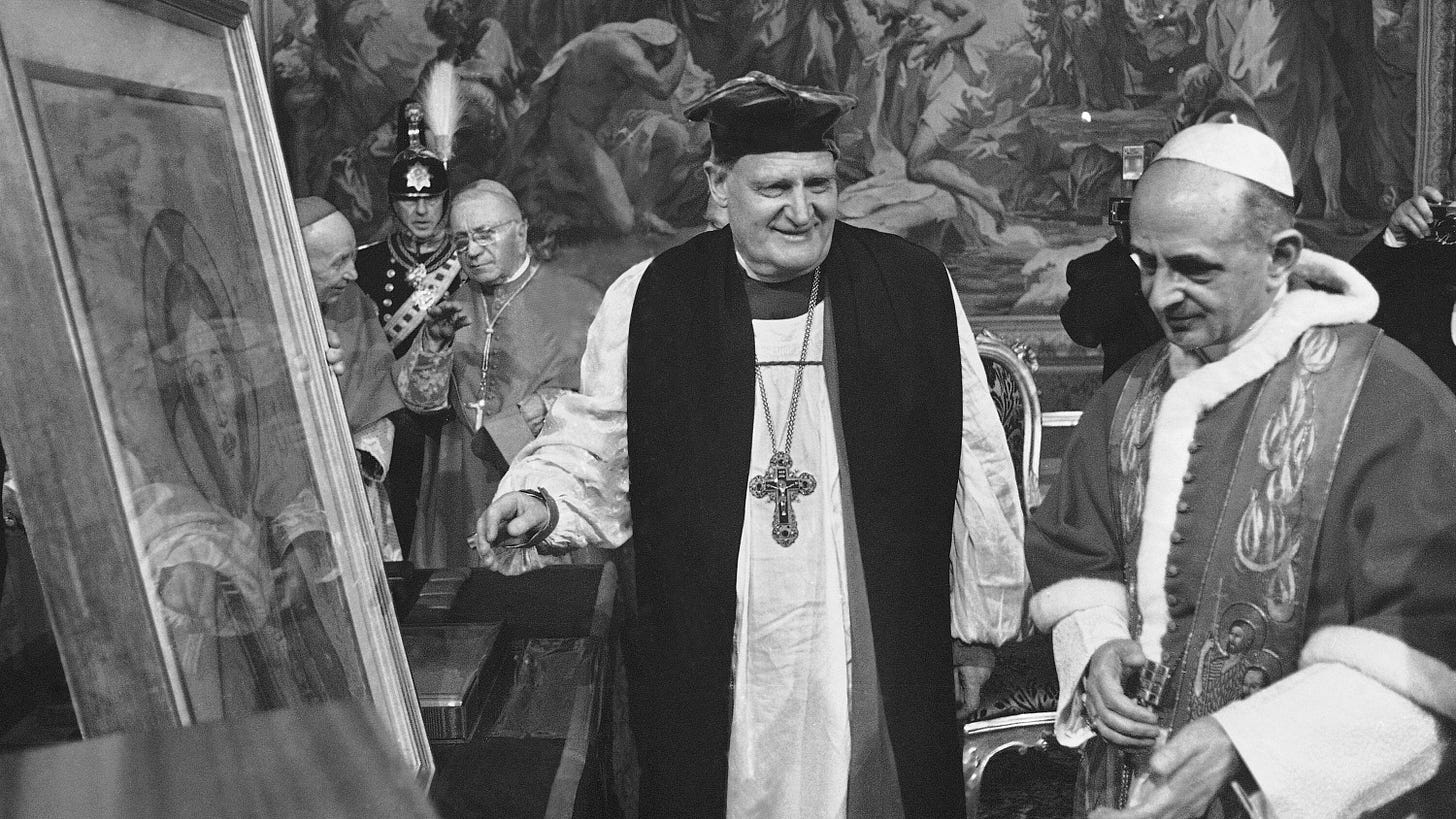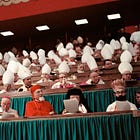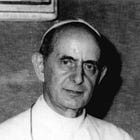'Paul VI's rite of ordination is invalid, copies Anglican rites'—Abbé Mouraux
Archbishop Marcel Lefebvre's friend and collaborator Abbé Henri Mouraux explains the consequences of the new rite of priestly ordination's similarities to the Anglican Ordinal—and it isn't good.

Editors’ Notes
Abbé Henri Mouraux and Archbishop Marcel Lefebvre
As we have mentioned a few times now…
Abbé Henri Mouraux was a longtime friend and collaborator with Archbishop Marcel Lefebvre. In the sermon for Mouraux’s golden anniversary of his priestly ordination, Lefebvre praised his faith and faithfulness, boldness and courage, and his refusal to cower under accusations of “disobedience.”
But what might surprise some is that Mouraux openly held that the post-conciliar claimants to the papacy were not true popes.
Mouraux was responsible for the bulletin Bonum Certamen, in which he advanced controversial theses, such as the invalidity or doubtfulness of the new rites of Holy Orders.
We have already translated Bonum Certamen No. 58 and No. 59 (1981), in which he critiqued the new rites of priestly ordination and of episcopal consecration.
Mouraux returned to the issue in 1991, addressing the matter again in two parts and in greater depth. This first part is on the new rite of priestly ordination.
Mouraux’s treatment of the new rite of priestly ordination
In this article, Mouraux considers again the comments of those who were using the new rites and explicitly disclaiming their sacramental efficacy, based on their own lack of intention to create sacrificing priests. He provides examples of ordaining bishops denying that these new rites created sacrificing priests distinct from the laity.
Mouraux also argues that the new rites create the same “defect of intention” which Pope Leo XIII noted in Apostolicae Curae, regarding Anglican orders. The similarities between Paul VI’s new rite of priestly ordination and the Anglican ordination rite forms the main focus of Mouraux’s critique in this piece.
This same angle was taken up by Michael Davies in his book The Order of Melchisedech. Davies delivered a devastating critique of this new rite of ordination:
“As a final comment on the new Catholic Ordinal, I would like to quote a passage from Apostolicae Curae and to ask any reader to demonstrate to me how the words which Pope Leo XIII wrote of Cranmer’s rite cannot be said to apply to the new Catholic Ordinal, at least where mandatory prayers are concerned. Pope Leo wrote of the authors of the Ordinal and
‘… the abettors whom they associated with themselves from the heterodox sects; and as to the end they had in view. Being fully cognisant of the necessary connection between faith and worship, between “the law of believing and the law of praying, ” under a pretext of returning to the primitive form, they corrupted the Liturgical Order in many ways to suit the errors of the reformers. For this reason, in the whole Ordinal not only is there no clear mention of the sacrifice, of consecration, of the sacerdotium, and of the power of consecrating and offering sacrifice but, as We have just stated, every trace of these things which had been in such prayers of the Catholic rite as they had not entirely rejected, was deliberately removed and struck out. In this way, the native character—or spirit, as it is called—of the Ordinal clearly manifests itself.’”1
Despite this and his numerous other criticisms, Davies nonetheless insisted that the new rite was still valid, because of the Church’s inability to promulgate or authorise invalid sacramental rites:
“The Church could not be considered a perfect, visible, supernatural society (and it is of divine faith that the Church possesses these characteristics) if the possibility existed of it offering its members invalid sacraments. If ever a pope approved an invalid sacramental rite the faithful would be deprived of a means of holiness necessary for their salvation, and hence the Church would have failed and the gates of Hell would have triumphed.”2
While this is true, it is also true that the Church is unable to authorise universal disciplines which are dangerous to faith or morals. Davies himself notes this in the same place, and—incredibly, after his scathing critiques of the liturgical reform—concludes that the new rites “contain nothing incompatible with the Catholic faith”:
“The doctrine of indefectibility guarantees that the supreme authority in the Church, the Roman Pontiff, could never impose or authorize for universal use throughout the Church any liturgical rite or practice that was contrary to sound doctrine, could invalidate the Sacrament, or undermine Catholic belief. In this instance the Roman Rite can be considered as equivalent to universal as it includes the overwhelming majority of Catholics throughout the world, and is proper to the Holy See itself. Thus, if the Latin Ordinal promulgated by Pope Paul VI in 1968, or the Latin Missal promulgated by him in 1970, are examined carefully, they will be found to contain nothing incompatible with the Catholic faith.”
It is truly incredible to read such words from Michael Davies himself, the arch-critic of the liturgical reform, as they seem significantly to walk back his prior criticisms.
However, such a walking-back really appears to be grasping at straws. Traditionalists basically only ever deny this when they have recognised that the alternative inexorably towards either a denial of traditional theology, the defection of the Church or—the only acceptable answer—an extended vacancy of the Holy See.
But the fact is that these rites are indeed harmful, and express and inculcate a different religion to that of the Catholic Church. This means that we cannot say that they come from the Church, or that they enjoy her approval, sanction or guarantees. This is why men such as Archbishop Lefebvre and others within the Society of St Pius X have affirmed explicitly that these new rites are not rites of the Church.
But rites which are not approved, sanctioned or guaranteed by the Church are not necessarily valid, and could be invalid; which means that they are subject to prima facie doubt.
This topic is addressed below:
The actual state of the question
As with the previous pieces, we are presenting this text solely for its historical interest, in that it shows the sorts of arguments current in the 1980s, amongst those with warm relations with groups like the SSPX.
The WM Review has refrained from arguing for a hard conclusion of invalidity of the new and reformed/deformed rites.
Nonetheless, one does not have to accept arguments for invalidity personally and fully in order to acknowledge that they give rise to a reasonable and prudent doubt about the rite of priestly ordination itself, and every single use of it. This is especially so given the number of different arguments converging on this conclusion.
This doubt is, in fact, not resolvable by studies or investigations: it is only resolvable by conditional repetition of the sacraments in question. As such this route of conditional repetition has frequently been followed by traditional groups since Vatican II.
This is justifiable on theological, practical and pastoral grounds. It is also justified on “customary” or “traditional” grounds, in that so many men involved in the traditionalist response to Vatican II—including Archbishop Lefebvre, Bishop Tissier de Mallerais, Fr Álvaro Calderón and many more—have held to these conclusions.
This route of conditional ordination is also justifiable on the grounds of natural justice: it would place those many men in an inescapable difficulty of conscience to impose a conclusion of validity upon them, even solely in practice. This is especially so, because even if one believes for oneself that the arguments have been refuted, it is the role of the Church alone to resolve such evidently open questions for all, and not private scholars or superiors of congregations.
Following this article, there is our usual reassurance for individuals ordained in these new rites, or who might be troubled by the ideas expressed.
Paul VI’s Ordinal is Invalid
Because it is a slavish copy of the Anglican Ordinal
Bonum Certamen, No. 118, Nov-Dec 1991
Part A—Study of the Priesthood
Translated by The WM Review, with additional line breaks for ease of reading.
“Ordination does not transmit priesthood, but only the mission” (Mgr. Vilnet).
The matter and form of the Catholic Priesthood
Theologians have long sought to determine, among the various rites of priestly ordination, which elements constituted the matter and the form of the sacrament.
Pius XII, by the Apostolic Constitution of 30 November 1947, using his supreme and infallible authority, definitively and irrevocably established the conditions for the validity of priestly ordination.
He decreed that the matter of the sacrament was the silent imposition of the hand by the consecrating bishop, and the form consisted of the words of the Preface, as handed down through Tradition.
Here is the Preface according to [the translation provided by Daniel Graham]:
“Almighty Father, we pray that you bestow on these servants of yours the dignity of the priesthood. Renew in their hearts the spirit of holiness, so that they may be steadfast in this second degree of the priestly office received from you, O God, and by their own lives suggest a rule of life to others. May they be prudent fellow-workers in our ministry. May they shine in all the virtues, so that they will be able to give a good account of the stewardship entrusted to them, and finally attain the reward of everlasting blessedness.”3
To these consecratory words are added essential supplements which confer authority over the Body of Christ, namely, the Mass, on one hand; and, on the other, authority over the “Mystical Body” of Christ, i.e., the Faithful, specifically through the administration of the sacraments.
Pius XII did not alter the millennia-old rite of ordination; he even prohibited any changes:
“No one,” he wrote, “shall have the right to alter this Constitution given by Us, nor to oppose it with rash audacity.”
Paul VI
And yet, Paul VI exhibited such audacity and rashness in publishing a New Ordinal.
Is it valid? Are men ordained since its publication in 1968 truly priests, or are they merely laymen, as Mgr. Vilnet asserts?
This is a grave question that I will attempt to resolve, remembering that J.-B. Montini (Paul VI) was drawn to Anglicanism from his seminary days. Once Pope, he displayed this affinity by giving his ring to the Anglican Primate (a mere layman) and inviting him to bless the crowd.
The Anglican Ordinal is invalid
This “Primate” was neither a priest nor a bishop. Leo XIII, in an infallible manner, decreed in his Encyclical Apostolicæ Curæ of 13 September 1896—which (the Pope clarifies) will always remain valid in all its force—that the Anglican Ordinal is entirely invalid.
The Ordinal of Paul VI and the Anglican Ordinal resemble each other like twin brothers.
Let us compare them in the light of sound theology.
This is a members-only post for those who support us with monthly or annual subscriptions.
Our work takes a lot of time and energy. Please consider subscribing if you like it.
Here’s why you should take out a membership of The WM Review today:
Help us continue building the case for a restrained, theological approach to the crisis in the Church
Eclectic and sometimes eccentric variety of content
Provide FREE membership to clergy/seminarians (subscribe and reply to the email if this applies to you.)
A small monthly membership really helps us keep The WM Review going. Can you chip in today?
In the meantime, you might enjoy this:




